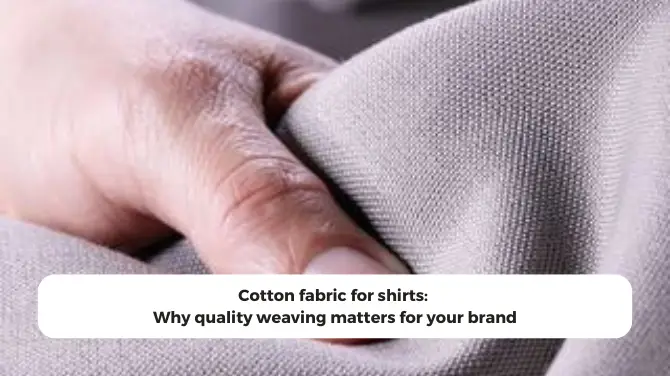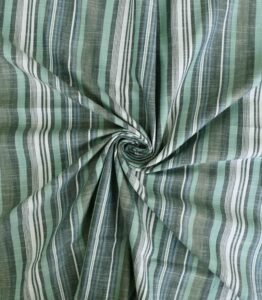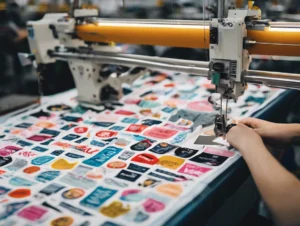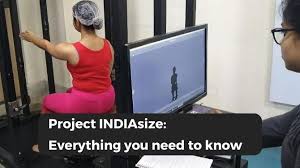If you’ve ever held a shirt that feels instantly “expensive” without looking flashy, chances are, it started with the right cotton fabric. Not just any cotton, but the right weave, weight, and finish for the shirt’s purpose.
For many brands, shirt fabric decisions happen late in the design process. The style is done, the trims are picked, but the fabric? Sometimes it’s an afterthought. The truth is, no amount of styling can fix a shirt made with mediocre fabric. If you want customers to keep wearing it (and telling others about it), the fabric has to feel right from the very first touch.
At Dinesh Exports, we’ve seen what happens when brands switch to a higher-grade woven cotton for shirts. The difference is obvious not just in the look, but in how customers respond.
What cotton fabric for shirts really means
Cotton shirt fabric isn’t just “cotton” in a generic sense. It’s about how that cotton is spun, woven, and finished. Two shirts can both say “100% cotton” on the label, yet feel completely different.
The type of cotton matters — long staple varieties like Egyptian or Pima give smoother yarns and finer weaves. But so does the construction. Broadcloth, poplin, oxford, twill — each weave creates its own texture, weight, and drape.
When you’re choosing fabric for shirts, you’re also choosing:
- How breathable and cool the shirt will feel
- Whether it has a crisp, smooth finish or a soft, brushed touch
- How well it resists wrinkles during wear
- How it holds dye, which affects the richness of your colors
The best cotton shirt fabric matches both the design and the wear context. A business shirt for an office line might need a lightweight poplin that stays crisp, while a casual summer shirt could use a slub-textured cotton for a relaxed, artisanal look.
Why weave quality matters more than many brands think
It’s easy to focus on fiber content and forget the weave. But in reality, the weave is where a shirt’s character comes from.
A well-executed weave:
- Distributes yarn tension evenly for a smoother finish
- Improves the fabric’s life and wash durability
- Affects how the shirt drapes on the body
- Plays a role in shrinkage and colorfastness
Cheap weaves can look fine on a sample, but after a few washes, they lose their shape or feel rough against the skin. That’s why our weaving process focuses on consistency. Every roll we produce has the same tightness, balance, and surface quality — whether it’s for a 500-piece run or a 50,000-piece production.
How we create shirt fabrics that stand out
Our cotton shirt fabrics start with carefully selected yarns. We work with both organic and conventional cotton, depending on buyer requirements, and use long staple yarns for smoother, stronger results.
In weaving, we control loom settings to match the intended shirt type. Fine poplins for formalwear get a precise, tight weave. Casual oxford fabrics on the other hand, have a looser, more textured structure. Once weaving is over, finishing processes like mercerizing, peach finishing, or soft washing give the fabric its final touch.
Because we handle weaving and finishing in-house, we can customize:
- Yarn count and construction
- Solid dyed or yarn dyed checks and stripes
- Finishes like wrinkle resistance or soft brushing
- GSM and weight adjustments for seasonality
Popular cotton shirt fabrics we offer
Poplin / Broadcloth – Smooth, crisp, and ideal for formal shirts.
Oxford – Textured basket weave, durable yet soft, often used for smart-casual styles.
Twill – Diagonal weave with a slight sheen, drapes well and resists wrinkles.
Chambray – Lightweight plain weave with a denim-like appearance.
Slub cotton – Irregular texture for a handcrafted look, perfect for casual collections.
We also develop blends when brands want the look of cotton with a touch of stretch or easier maintenance.
How to choose the right cotton shirt fabric for your collection
When selecting shirt fabric, always look for:
Climate and season – Will the shirt be worn in summer heat or cooler weather?
End use – Office wear, resort shirts, uniforms, or everyday casual?
Brand identity – Crisp and sharp or soft and relaxed?
Care instructions – Will your customers expect easy-iron or natural wash-down effects?
We often recommend brands get swatches in multiple weaves to compare how they feel in the hand and how they look in natural light.
For example, if your audience is professionals, a fine poplin in pastel shades can hit the right note. For travel-friendly collections, a cotton-lyocell blend with a soft finish might work better.
Why sourcing from us makes a difference
Many suppliers can offer cotton fabric for shirts. The difference is in control and consistency. At Dinesh Exports, we:
- Weave and finish in-house for full quality control
- Offer low MOQs to support smaller runs and capsule collections
- Provide yarn dyed, solid dyed, and printed options
- Use sustainable yarn sources when requested (organic, BCI-certified)
- Back every order with pre-production sampling and lab dip approval
Our clients range from boutique labels to large-scale fashion houses, and in every case, the focus is the same — make sure the fabric meets the brand’s expectations before it goes into full production.
Watch how shirt fabrics come to life
Here’s a useful video on shirt fabric production that shows weaving and finishing in action:
Learn more about shirt fabrics
For a deeper dive into shirt fabric types and their properties, check out this detailed guide from CottonWorks.
Let’s develop your next shirt fabric
Cotton fabric for shirts isn’t just about the fiber. It’s about matching the right weave, finish, and weight to your brand’s style and your customer’s lifestyle. That’s where we come in.
If you’re planning your next shirt collection and want fabrics that balance quality with cost efficiency, reach out to us. We’ll send swatches, discuss weave options, and help you find a fabric that’s exactly right for your market.
Your customers will feel the difference. And that’s what keeps them coming back.




